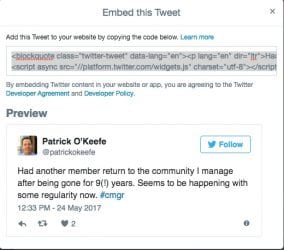The (Il)Legality of Embedding Tweets
No, the internet is not on fire...
 Last week, judge Katherine Forrest of the Southern District of New York handed down a judgment that sent shockwaves through the internet.
Last week, judge Katherine Forrest of the Southern District of New York handed down a judgment that sent shockwaves through the internet.
Ruling in a case that pitted photographer Justin Goldman against several news sites, including Yahoo, Brietbart, The Boston Globe and Heavy.com, the judge ruled that the news sites may be held liable for embedding tweets that contained his photo.
The ruling has the potential to upturn over a decade of legal thinking in the U.S. and drastically shift the responsibilities websites have when it comes to embedding content. This, in turn, may mean significant changes to YouTube, Twitter and any service that enables content to be embedded elsewhere.
It may also drastically change the fight against piracy and the more modern pirate sites by simply changing where legal liability falls.
However, none of those changes have happened yet and, to be honest, they are unlikely to do so at all. Furthermore, if there are major legal shifts ahead, they will likely be more limited than the initial analysis has led many to believe.
To understand why all of this is, we first have to look at the ruling itself and understand why it’s both extremely important and extremely unimportant at the same time.
Understanding the Case and Ruling
 In 2016 Goldman snapped a photo of New England Patriots quarterback Tom Brady and Boston Celtics general Manager Danny Ainge as they walked down the street. The photo came as the Celtics were working to recruit Kevin Durant to the team.
In 2016 Goldman snapped a photo of New England Patriots quarterback Tom Brady and Boston Celtics general Manager Danny Ainge as they walked down the street. The photo came as the Celtics were working to recruit Kevin Durant to the team.
Goldman, however, didn’t post the photo on Twitter and, instead, posted it to his Snapchat story. At least some of his followers took the photo and posted it elsewhere online. The image soon made its way to Reddit and Twitter, where several news outlets picked up on it.
However, those news outlets did not copy the image and upload it to their servers. Instead, they simply embedded some of the (already infringing) tweets that contained the image. Still, Goldman sued claiming that the publications violated his right to control the public display of his image.
But, despite the lawsuit, most felt that the publications would be fairly safe. The reason is because, in 2007, the 9th Circuit handed down a ruling in the Perfect 10 v. Amazon case that treated embedded content (in that case pornographic images) like links.
The Appeals Court put the focus on where the images were stored. The liability would rise with those who stored the image and/or uploaded it, not those who merely linked to it. That’s true even if the “link” is an inline embed that is largely invisible to the end user.
This established the “server test”, which has more or less be the guiding standard when it comes to embeds for the past decade.
But this new ruling challenges that test. Since New York is in the 2nd Circuit, it isn’t beholden to the 9th Circuit’s ruling. As such, the judge ignored the ruling (and the various amicus briefs asking the court to uphold it) and said that the logic was flawed and, that even if it wasn’t, it shouldn’t provide as much protection as it has in the past.
The judge instead looked to the 2014 Supreme Court ruling in the Aereo case. That case, which dealt with internet streaming of over-the-air broadcast television, saw the high court say that “should not hinge on invisible, technical processes imperceptible to the viewer.”
To judge Forrest, that sounded a great deal what an embed is, an invisible, technical process that is often imperceptible to the viewer.
But, even if the server test is valid, judge Forrest argued that it shouldn’t be applied to all situations equally. According to her, search engines are only taking action at direction of the user. News organizations, however, are sharing the content whether the user requests it or not.
The ruling, which is denying summary judgement on behalf of the publications, means that the case moves forward.
Why It’s Not a Big Deal (Yet)
News coverage of the ruling has made it seem far more important than it is, with many making it sound like an apocalypse in the making.
However, at this time, the 9th Circuit ruling is still the highest court ruling on this issue and the case itself is still early on. The denial of summary judgment simply means that the case moves forward toward a possible trial, not that the publishers have lost. They still have other legal defenses, including fair use, that they can raise.
In short, this ruling didn’t change anything immediately (even within the case itself), it merely made this a case to watch closely.
For this ruling to have any meaningful impact, it’s going to have to survive its probable appeal. But, even then, that would merely create a circuit split. That split, if it were to happen, could create some very real chaos as courts in one circuit would rule differently than courts in another on this issue. Other circuits would also likely weigh in as new lawsuits are filed in their courts.
We’re seeing something similar now with the issue of copyright registration or application being necessary to file a lawsuit.
That split, if it happens, would have to be resolved by the Supreme Court and that could take years.
In short, we are years away from this becoming a new national standard of liability and the process is fraught with many hurdles that make it unlikely.
Still, it is much more likely than it was just two weeks ago and that is why the potential impacts are still worth discussing.
Some of the Possible Impacts
If this ruling overcomes the hurdles before it and if the publications are ultimately held liable, it would represent a major shift in the way the law looks at embedding and that will have impacts far beyond Twitter.
Sites would have to be careful when embedding YouTube videos or SoundCloud files to make sure that they are non-infringing. Basically, they would have to treat those videos the same as if they were uploading them to their server directly, checking to make sure that they either have permission or that there is a clear fair use argument.
This would not have an impact on embedding content legitimately uploaded to Twitter, YouTube, etc. If you were to embed one of my YouTube videos, you would be fine since you already have permission by the fact I enable embedding, which grants blanket permission, and the content is original to me.
However, if I were to upload an episode of a popular TV show without a license, embedding that, under this legal theory, would mean you could be held liable. Under the server theory, the liability would be my own and possibly YouTube’s if they failed to remove the video after notification. But, if this new approach takes hold, it would extend (potential) liability to anyone who embeds it.
This new approach wouldn’t just impact webmasters and news organizations, it could also shift the fight against piracy. Many pirate sites don’t directly host content but, instead, embed it from (usually overseas) sources. While other legal theories have been used to bring down many of these sites, it could provide a new tool for holding them liable.
Still, the biggest change would be how legitimate sites embed content from third parties. It would have to be vetted the same as anything they uploaded directly and that may hurt embedding as a concept. After all, one of the reason major news sites love it is because of the legal protection it currently provides.
If that changes, news sites will likely shift away from embedding, preferring control over convenience, and that would drastically alter both how they display content and how they attribute it.
Bottom Line
Embedding, when done ethically, is good for everyone. Original creators get their content viewed directly and have control over attribution while embedding sites get a convenient tool to add the content into their pages.
But cases like Goldman’s raise serious questions about what happens when the content being embedded is, in and of itself, an infringement. Who should be held responsible? While the uploader is obviously the primary infringer, what about those who embedded it and both increased the exposure to the infringement and benefited directly from it?
While nothing has changed yet, these are the questions being asked and now a New York judge has come up with a different answer than what the decade-long status quo gave us. While it’s just one judge’s opinion right now, if it goes much beyond that, it will likely change the way sites approach embedding.
But, if that change does come, it likely won’t be as catastrophic as many fear. Sites being more careful about what they embed (or favoring direct upload) won’t end the internet or sharing content.
It would just shift HOW that content is shared.
Want to Reuse or Republish this Content?
If you want to feature this article in your site, classroom or elsewhere, just let us know! We usually grant permission within 24 hours.
